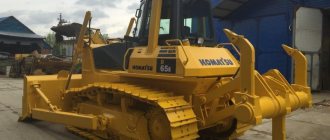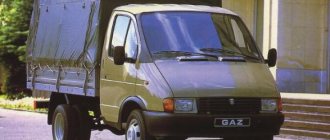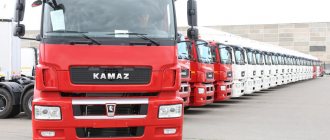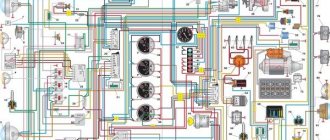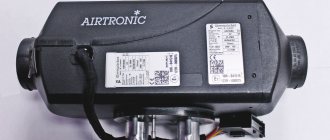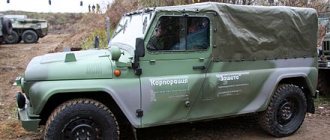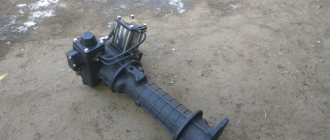MAN buses
MAN
MAN: MAN Nutzfahrzeuge AG, Dachauer Strasse 667, 80995 Munchen, Germany The world-famous manufacturer of trucks, the German corporation MAN, produces an equally impressive range of all kinds of buses. At its plant in Salzgitter, MAN assembles a whole range of city, intercity and tourist buses, as well as an even larger series of chassis on which specialized companies install various bodies of their own manufacture.
.
Ale Series
The main novelty in the MAN program is considered to be the small low-loading 3-door city bus Ale with a gross weight of 9.5 tons. Its development has been carried out since 1997 together with the Italian coachbuilder Autodromo. A 4-cylinder diesel engine with 175 hp is installed in the rear overhang of the bus. and automatic 3-speed transmission. Its overall length is 7.5 m, width is only 2200 mm, maximum capacity is 60 passengers (seats are 10–17). The features of the new bus include electronically controlled air suspension (front - independent), disc brakes on all wheels, installation of ABS and ASR, steering wheels with a turning angle of 52°, aluminum and plastic facing panels glued to the steel frame
.
Lion's City Series
MAN NM 222
In 2000, the program included the 3-axle Lion's City city bus with a total capacity of 120 passengers. In addition, MAN offers several types of 2- and 3-axle chassis (models from 8.153HOCL to 24.420HOCL) for mounting bodies of specialized companies on them. Lion's Comfort Series In recent years, a simplified tourist-intercity version of the RN353 Lion's Comfort with engines of only 350 hp, designed to carry 49–55 people, has been created. On the other hand, the “lion series” has been replenished with tourist options of special comfort - the 2-axle Lion's Star Spezial and the 3-axle Lion's Top Coach (6x2
).
Lion's Star Series
Produced since the early 90s, the Lion's Star tourist series with engines of 400 and 420 hp. replenished with the most powerful version with a 12.8-liter D2876 engine producing 460 hp. and torque 2100 N.m in 1000–1300 rpm mode
.
Midibus series
The second new product is the mid-sized low-loader city bus Midibus with a gross weight of 22.5 tons in versions NM223 and NM283, with engines of 220 and 280 hp. With. respectively. It is available in three versions with a length from 8.5 to 10.5 meters and an overall width of 2350 mm. Total capacity - 80 passengers. The bus was created by shortening serial 12-meter buses of the NL series while maintaining all their advantages. A new technical solution was to install the engine vertically on its own subframe, forming an easily removable module attached to the supporting frame of the body with four bolts. The bus uses a new ZF portal-type rear drive axle, all disc brakes, steered wheels turning at an angle of 50°, an EBS electronic system for diagnosing and monitoring the operation of the braking system, combined with ABS and ASR. The driver can work safely in a completely isolated cabin. It manages and monitors the operation of all systems using the NES electronic system, which displays all information on mini-monitors and is integrated with a single electronic processor for controlling bus units. It also includes the CAN “body electronics” system, which monitors the operation of doors, lighting, alarms, heating, etc.
.
Series NL
At the end of the 1990s, MAN created an updated unified system of low-load two-axle city buses NL263, NL313 and NL363 with a length of 12 meters, equipped with new, more economical and environmentally friendly diesel engines with a power of 260, 310 and 360 hp. With. and an automatic three-speed transmission, the service interval of which reached 60,000 km. Given these advantages, the base model NL263 received the title of "Bus of 1999"
.
Series NU/NG
Based on the NL series, a family of intercity buses was developed under the symbol NU, the length of which was increased to 13.7 m. In 2000, a third range appeared, including single city 3-door low-frame models NL263-15, NL313-15 and NL363-15 (6x2 ) 15 m long. Their 2-door versions NU313 and NU363 were intended for intercity routes. With about 50 seats, they can carry up to 125 passengers at a time, that is, the same number as articulated 18-meter vehicles. These buses are equipped with power steering for the main steering and electronically controlled rear axle drive mechanism, all disc brakes with EBS, ABS and ASR systems. Based on them, articulated buses NG313 and NG363 are produced. Most of these buses have become mobile laboratories to test the feasibility of using promising new fuels and drive systems. These include the NM152E electric bus, the NL202DE diesel-electric bus, the NL232 single compressed natural gas (CNG) vehicles and articulated fuel cell or hydrogen fueled buses.
.
MAN Lion's Coach
MAN NL 313-15m
- MAN Lion's City
- MAN Lion's City M
- MAN Lion's City LL
- MAN Lion's City G
- MAN Lion's City O
- MAN Lion's City ULL
- MAN Lion's Classic
- MAN Lion's Classic G
- MAN Lion's Classic O
- MAN Lion's Regio
- MAN Lion's Regio L
- MAN Lion's Coach
- MAN Lion's Top Coach
- MAN Lion's Comfort
- MAN Lion's Star
- MAN Lion's Top Star
- MAN NL243GPL
- MAN NL263
- MAN NL363
- MAN SU283
- MAN SU313
- MAN SU363
TEBS wiring diagrams for MAN buses - Auto parts and auto tricks

Main menu:
- Let's begin...
- < manuals > DIAGRAMS in one click DAF XF-105 2006-2013
- XF 2013-2017
- 95XF
- MAGNUM 2000-2006
- Tricks
- KP
- WORKSHOP Information READING THE DIAGRAMS
- Practice
- Codes 5556, 5038
- SPN 3673
- Supercharging
- EDC EDC
- EBS
- OBD system
- TGS / TGX Wiring diagrams
- Usage
- Electrical circuits
- EDC MS 5 Troubleshooting
- Functional description
- Troubleshooting
- Fault codes
- Fault codes
- Fault codes
- Fault codes
- Fault codes
- Fault codes
- Fault codes
- Fault codes
- TGA AS-Tronic
- Fault codes
- Fault codes
- Fault codes
- Description
- Fault codes
- Fault codes
- Fault codes
- Fault codes
- Airtronic Fault Codes
- Description
- Fault codes
- Fault codes
- Fault codes
- Fault codes
- Fault codes
- Description
- Electrical equipment
- MAN EURO 6
- Tricks
- MX-11/MX-13, EN2/14 MX motors
- PACCAR
- "MIL" for ECS-DC4 and EAS
- Decoding
- ECAS-2
- ABS/ASR-D
- EST42
- EAS
- Abbreviations
- troubleshooting
- EST 52
- ACH-EW
- EBS
- Cabin suspension
- CAN Topology
- ZF EST42
- EBS 2
- Description
- Pneumatics
- BBM
- Electrical circuits
- Electrical circuits
- Diagnostics
- Components LF45 IV, LF55 IV
- ACTROS 950-954 Reg. engine
- Tricks
- MR euro 2-3
- MR "Code"
- Rear module
- Automatic transmission GS II
- Automatic transmission GS II
- TCM TCM
- MCM
- ATEGO codes 950-954
- Wiring diagrams MR OM904
- ABS wiring diagrams
- Wiring diagrams MR MR
- ABS/ASR
- MR Electrical Diagrams
- ADM wiring diagrams
- HYD wiring diagrams
- Wiring diagrams MR
- Wiring diagrams MR
- SPRINTER 909 CR4_T1N-OM646
- CDID3S2-OM651
- EURO TRAKKER Wiring diagrams
- TECTOR
- Electrical circuits
- Electrical circuits
- Eurotronic gearbox
- Repair zone Workshop HPI with EDC S6 Fuel pressure
- in winter
- Introduction
- Engine
- Description
- Diagnostics
- Description
- EBS System design
- ABS BOSCH
- Diagnostics
- PDE (EDC) MS6 Diagnostics
- Description MS5
- Components
- AGR
- Rem. Smoke zone
- VIN code
- Balance checks. cylinder
- Description of FM4
- FH4 D13 A400
- EBS Description
- Description
- FM (4) Wiring diagram
- Electrical circuits
- Designations
- Electrical circuits
- Electrical circuits
- FH (4) Wiring diagrams
- ECM
- MID 128 D9,D12,D16
- MID 144 codes
- VN/VHD/VAN
- euro 6
- Service
- TRAINING...Wiring
- LCM
- Designations
- Electrical circuits
- Electrical circuits
- EURO 4 Wiring diagrams
- Electrical circuits
- Electrical circuits
- Electrical circuits
- Service. instructions
- AUMAN Electric system
- CARGO Wiring diagram
- Training Fuse Box
- Fault codes S05C / D_S05C-TB
- J and S series
- Electrical circuits
- Electrical circuits
- Components
- SX3255DR
- Electrical diagram
- Canter EURO 3 Wiring diagram
- Common rail engine
- FLC Cummins
- T800
- MB EURO 3/4 scheme
- Cummis CM2150 Wiring Diagrams
- BOSCH MS 6.1
- crankshaft/camshaft
- CUMMINS
- AS-Tronic
- Description
- 5490 Electrical diagram
- ABS
- ABS
- 6370 ABS 6 Device
- Rem. VOLVO zone Reading diagrams
- Electrical circuits 203
- Scania Touring Electrics
- Automatic transmission ZF
- Pneumatics
- Suspension ELC suspension
- B12B_B12M
- BH120F
- NL243/283
- Electrical circuits
- 5292_22
- Futura
- ECU CM2150E
- Engine
- SB 220 GS/LT
- XMQ6120C
- E200 MMC
- A092 / A0921
- ETS and MTS
- Komatsu Tech. documentation
- PC200(220) 6 Excel
- CAT Dictionary
- EX300 - 5
- Collection of schemes
- LTM 1100 Fault codes
- LR1600
- Fault codes
- EK-18 Perkins
- Mega collection
- JS145W
- Fault codes Telescope CODE
- Mini loader
- Fault codes
- Fault codes
- Front. episode 3
- Tractor T6 fault codes
- Tractor T9
- Front Loader
- Front. episode 3
- Fault codes
- Electrical circuits
- Wiring diagrams DL
- D.L.
- BW 213 / 214 Wiring diagrams
- Wiring diagrams CVT 6140 - 61195
- Reading the diagrams
- 350D and 400D-II
- 210K EP
- 540H and 548H
- 9120 — 9620
- 335C
- 318E and 320E
- 210LE
- 9560, 9660 Circuit diagrams
- XCG 210LC-8B
- Electrical circuits
- Jaguar 695
- Service info.
- A350 schematics
- Scheme
- SUPER 2500
- BHL
- SAME
- H12T-H20T
- Collection of schemes
- Service manual
- Service. collection
- LOGLIFT 59
- NH/Case/Steyr
- WORKSHOP Knorr simulator
- ECAS
- Systems
- EBS D system
- Components
- EBS E system
- Thermo King Wiring Diagrams
- Electrical circuits
- System
- TEBS TEBS 4
- VOLVO VOLVO PTT 2.7…
- Autocom Mercedes Actros Diagnostics
- Diagnostics-video
- ABS sensors
- DAVIE DAVIE and fuel
- ABS 6 Diagnostics
- Rem. TEBS E zone
- Components
- Description
- Teplostar 14TS-10
- Fault codes
- Heater calculations
- AIRTRONIC
- 4D-24
- AT 2000
- Description
- Webasto BBW/DBW46
- Thermo 300
- DAF
- CUMMINS Cummins ISB/ISBe Fault Codes
- Fault codes
- Description
- Fault codes
- Diagnostics
- EMR3
- Tier 3 fault codes
- DDEC components
- 4.5L and 6.8L
- MX-13 Fuel
- TELMA Wiring diagrams
- 3000_4000 series
- ESU - 1A Diagnostics
- Description of the ECU
- CM2150
- CP faults
- ABS-T Diagnostics
- Screen components
- VOCOM I, II
- Spare parts store (used) MAN
< manuals > > Buses > MAN
TEBS electrical diagrams of the MAN bus model range
The entire list of TEBS systems for MAN buses is a lot!
Only users can view and print them in high quality
"Big encyclopedia for auto electricians and diagnosticians"
Let's begin... | <manuals> | ENCYCLOPEDIA | Services... | Contacts | Home Site Map
Three new MAN passenger buses began operating on the Magadan – Airport route
One of the largest Magadan carriers, Magadan Auto LLC, presented three new MAN buses in Magadan. The event was attended by the mayor of the city, Yuri Grishan. The cars have already entered the line and are working on route No. 101 (111) “Magadan - Airport”. The new buses have 55 seats inside; they are distinguished by increased comfort for passengers and an increased distance between seats, which is important in a pandemic. The technical characteristics of this model correspond to the climatic characteristics of the territory, the press service of the Magadan City Hall told MagadanMedia.
Mayor of Magadan Yuri Grishan:
“It is very important that the rolling stock is updated. This is also a component of the city’s appearance.”
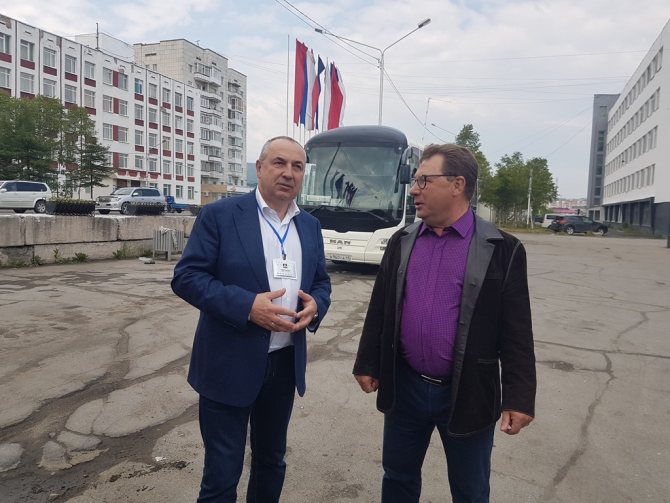
New buses. Photo: Magadan City Hall
“Passengers will be comfortable in these buses in any season - not hot in summer, but warm in winter. We renew our vehicle fleet annually. Last year and the year before we bought two new cars, and this year we bought three. We are trying to improve the quality of service, we see that passengers also like it,” said Alexander Kramarenko, head of Magadan Auto LLC.

New buses. Photo: Magadan City Hall
New buses were purchased at the carrier’s own expense. The presence of a service center in Magadan for servicing MAN vehicles also became one of the arguments in favor of choosing this model. The quality of the buses has already been appreciated by drivers and passengers.
“I’ve been driving for a long time, I have something to compare with. The car is soft and comfortable. By driving it, you get less tired during the day. The bus has decent technical equipment, what is needed for our roads. And passengers are more comfortable - a large and spacious interior,” said driver Vladimir Satin.
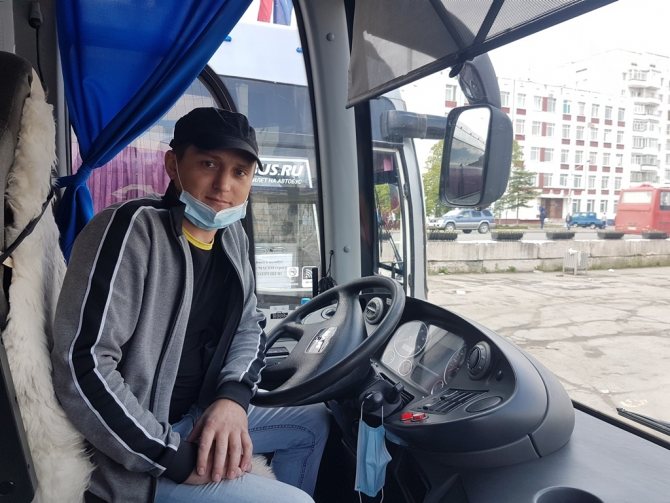
New buses. Photo: Magadan City Hall
Working during a pandemic, the carrier provides all recommended safety measures, conducts temperature measurements and regular disinfection, and drivers are provided with personal protective equipment. Magadan Auto LLC operates bus services on routes No. 101, 111 (“Magadan – Uptar – Airport”), and also carries out intraregional transportation between settlements in the region.
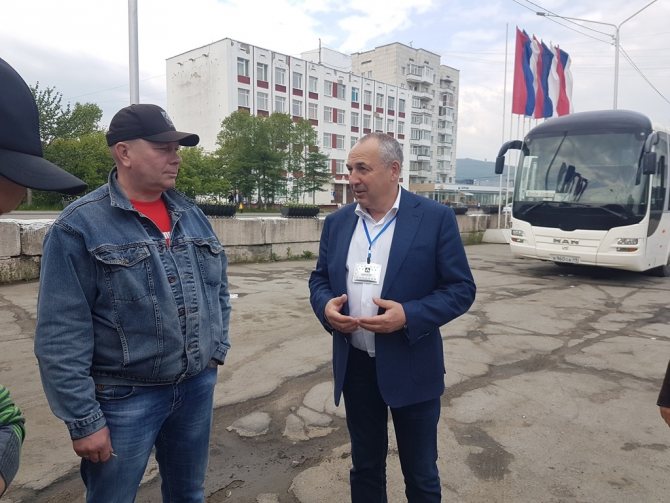
New buses. Photo: Magadan City Hall
Every day 15 cars enter the line. There are 25 flights to Sokol Airport every day. In addition, the head of the municipality, Yuri Grishan, spoke about plans to update the bus station:
“The condition of the bus station is of serious concern. We are now starting to repair the electrical power system here. The building has electrical and plumbing problems. In Magadan, they are already using technologies for the production of display aluminum window blocks; we plan to replace the glazing this year and make a ventilated façade. The facility has been in need of renovation for a long time, and the state it is in now is a pain and a shame. For a long time its status and jurisdiction were determined. Now we need to put it in proper shape.”
C'mon, I'm on top: test drive of the MAN SD200 bus
Craving for the standard
Red double-decker AEC Routemaster buses have long become a symbol of London, but little is known about their German relatives. But in vain, because here, too, “multi-tier bus construction” was no worse developed than in the UK. There were mainly four manufacturers represented on the market: Büssing, MAN, Magirus and Mercedes-Benz. All of them, of course, coped with their tasks, built with high quality, but the transport enterprises operating and maintaining this equipment had a hard time: the buses were of different types, and the Germans, accustomed to order, simply sometimes overheated their brains.
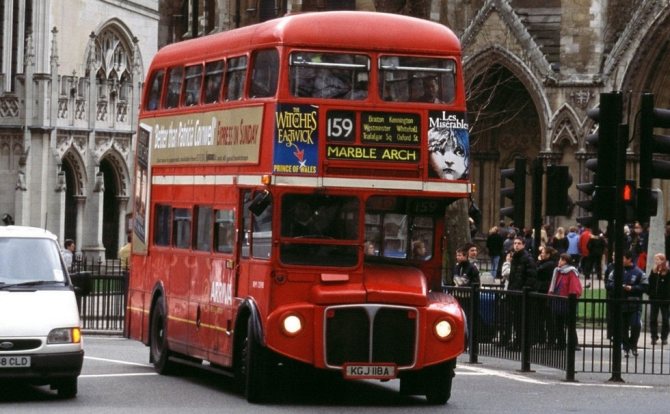
Pictured: AEC Routemaster '1954–68
And then the Verband öffentlicher Verkehrsbetriebe (I won’t even try to write a transcription, but in Russian it’s “Association of Public Transport Companies”) decided to put an end to bus sloppiness by introducing a single standard type of bus. From now on, all German buses had to have the same passenger compartments, seats and windows. The drivers' jobs should have been as similar as possible.
Armed with new standards, experience and the desire to make money, Berliner Verkehrsbetriebe and MAN set about jointly designing a new standard bus. It would seem, what does this same Berliner Verkehrsbetriebe have to do with it? Moreover, he was the first carrier to receive the new MAN SD 200 Gaubschat (SD73) bus in 1974, a year after the bus was first shown at the Frankfurt Motor Show.
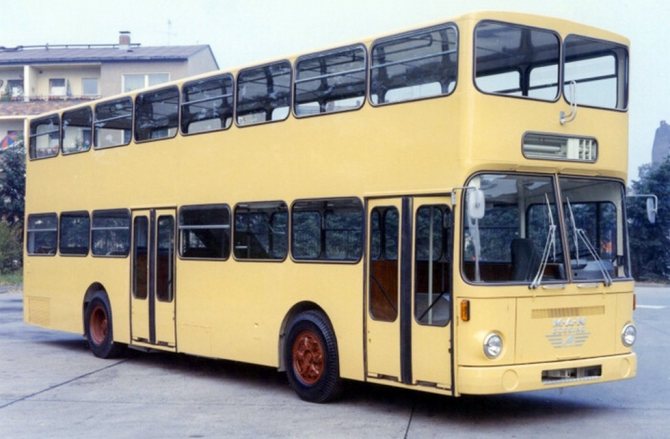
Pictured: MAN SD 200 Gaubschat (SD73) '1973
As the name implies, the body was handled by Gaubschat, and MAN products were used as the chassis. Only two of these buses were built, and it was with them that the era of the double-decker MAN SD200 began. SD stands for Standart Doppeldeckerbus, which translates to "standard double-decker bus".
Almost at the same time, another company, Büssing, was engaged in the construction of bodies. There the guys tensed up and made as many as three buses. The main supplier of bodies was Waggon Union GmbH, which produced most of the buses - more than seven hundred units. They worked from 1974 until the very last year of production of the MAN SD200 - 1985. And our bus today is from exactly this manufacturer and the same last year of production. How did he end up in St. Petersburg? Oh, that's a whole story!
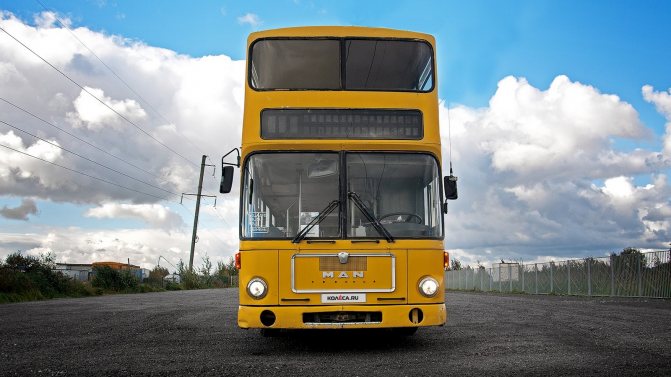
An unusual bus for an unusual person
I have never seen a single normal creative person. They are all a little bit crazy, that is. At the same time, some are absolutely unbearable, and some, on the contrary, attract you. I am very lucky that the current owner of the bus, Vladimir Nikiforov, belongs to the second type of creative people.
Even though he is an artist and works in a variety of crafts, he is an absolutely adequate person, moderately bearded and cheerful. Actually, that's why he needed a bus. Vladimir is the head of the network of creative studios MASTERKLASS. Not only children, but also adults study in the studio. It is sometimes inconvenient for both of them to get to it, no matter where it is located. And then the idea came to make a mobile meeting place. The idea, in general, is not new: there are such studios on wheels in Moscow. Why not do the same in St. Petersburg? Vladimir specially studied for category D for this purpose and began to look for a suitable vehicle.
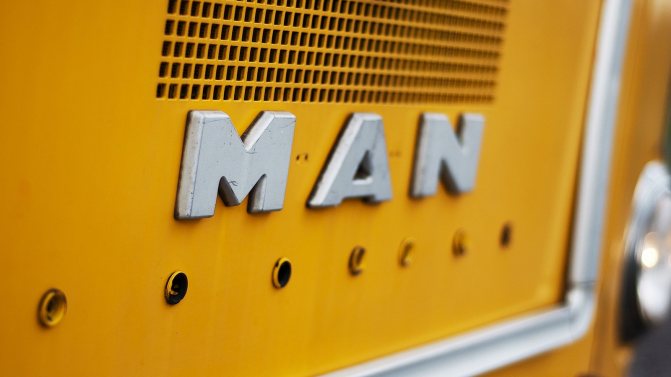
It soon became clear that an ordinary bus would not be suitable: given that it would be necessary not only to travel, but also to work, there was not enough space. And then Vladimir began searching for a double-decker bus. The first one was found quickly, in St. Petersburg. But it was partially disassembled, dismantled, and the price they asked for was high. Having estimated how much more would have to be invested in the purchase, I had to abandon this acquisition. Exactly the same MAN was found in Barnaul, where it worked on a regular city route. Having resolved the money issue, Vladimir flew to Barnaul.
They greeted him so well that they even carried out maintenance on the bus in two days: they replaced the engine oil, injected the suspension, replaced the pins and fluid in the automatic transmission.
Now imagine the complexity of the situation: from Barnaul to St. Petersburg is about 4,500 kilometers, there is category D, but there is no practice in driving buses (as well as good knowledge of technology). I had to travel alone on a thirty-year-old bus, periodically getting into blizzards and rain... And until that moment, the bus had just stood there for at least a year and didn’t go anywhere at all. Not everyone would dare, to be honest. And Vladimir went.
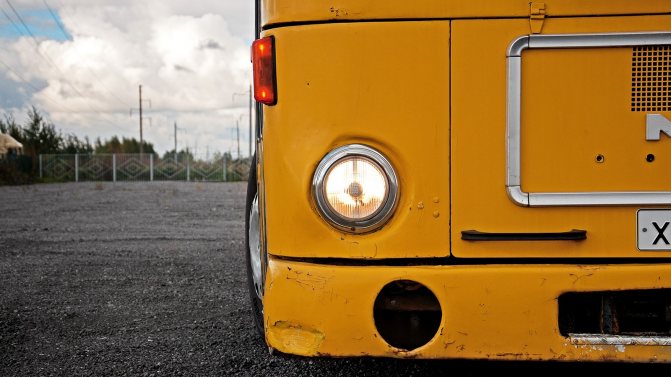
Transmission
automatic transmission
Voith DIWA D85 1.2
The tires, “scarred” by time, did not allow me to drive faster than 40-45 km/h; I had to regularly pull over to the side of the road to let the traffic piling up behind me pass. Between Novosibirsk and Omsk the pre-heater blazed, then the gearbox went into emergency mode, and the speed dropped to 20 km/h. In Omsk they were able to repair the box in just a couple of hours, but in Tyumen they had to stand still again: a blizzard with wet snow raged, and it was almost impossible to drive. On the Perm-Izhevsk highway, MAN showed a tendency to smoke brake pads, but this was already a trifle.
Vladimir left Barnaul on April 18, and arrived in St. Petersburg on the holiday morning of May 9. “We sing a song to the madness of the brave,” as Maxim Gorky sometimes used to say.
Four meters above road level
The first thing we notice is the height of the bus. It is almost 4 meters, but the other dimensions are not small: 11.5 meters in length and 2.5 in width. If the bus were single-decker, it wouldn’t seem like a baby either. Before entering the salon, let's inspect it from the outside.
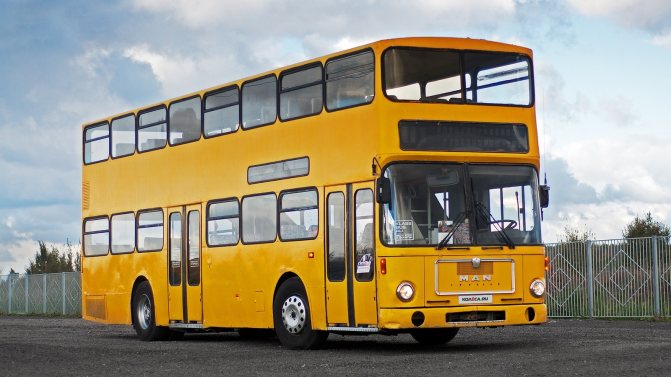
Engine
diesel 11.4 l MAN D2566 UH, 200 l. With.
During the entire production period, the body was repaired several times - mainly, of course, in small things. The exterior is not replete with decorative elements, so the whole bus seems not only boring, but quite simple and utilitarian. Let's try to open the compartments located outside and see what is hidden in them.
Since the engine is located at the rear, under the cover between the headlights you can only see the elements of the cooling system and to the right of the radiator - the steering gearbox. You can also get to it through the right side hatch. All the electrics are located on the starboard side, and let’s pay attention to the wires: they are marked with German accuracy, which in case of repair makes it much easier to find the right wire. There are also compartments with batteries and a pre-heater. By the way, traces of the fire that happened along the way are still slightly visible on its lid.
1 / 3
2 / 3
3 / 3
There is access to the engine from the rear, but it can be seen much better through the hatch in the floor of the cabin. Here the in-line six-cylinder diesel engine MAN D2566 UH, the volume of which is 11.4 liters, laboriously turns the crankshaft with its pistons. It produces 200 liters. With. and 740 Nm of torque. It seems like a lot, but adjusted for weight, to be honest, not very much.
1 / 5
2 / 5
3 / 5
4 / 5
5 / 5
At the same time, we look into the adjacent hatch in the floor. There we see an automatic transmission and immediately unmistakably identify its brand - it’s Voith DIWA D851.2 (just kidding, I couldn’t identify anything there by eye, I looked in the manual). This is a classic three-stage hydromechanical unit, quite durable. Well, since we’ve already got to the salon, let’s take a look at it too.
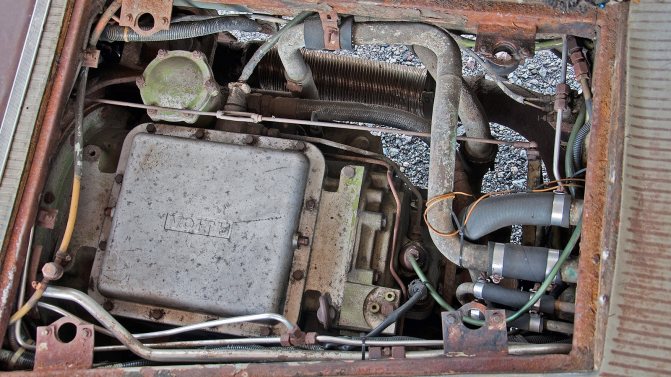
Yes, you can feel the harsh hand of Barnaul here. It was not possible to identify the installed seats, but they are definitely not “original”. There shouldn’t be any stairs in the back either, but the front, “original” factory staircase has been preserved in its original form.
Let me remind you: we are in a mobile workshop, so we cannot do without redevelopment. Moreover, sometimes there may even be a potter’s wheel standing behind here; there are different crafts.
The synthesis of Barnaul-German heritage here is enchanting. What remains are the original signs, the route plan for Barnaul, the light displays, and colored patches of unknown origin on the ceiling. But let’s not be sad about this: 31 years is a serious age, and the bus is quite alive.
1 / 2
2 / 2
You can't ride standing on the second floor: the ceiling is low, and the rules prohibit it. But before I drive myself, I take a seat in the first row of the second floor and ride with a “personal driver”. Beauty! View, space, feeling of freedom. It is interesting how the ventilation is done: the upper glass windows are motionless, but there is a gap between them. Like it or not, ventilation is carried out, the most forced one.
1 / 4
2 / 4
3 / 4
4 / 4
There was once a real periscope here! This system allowed the driver to observe what was happening on the second floor.
Driving a bus
To get behind the wheel, we open a metal barrier, then a small door near the seat. The front part of this partition functions to regulate the amount of air coming from the stove. We sit in the driver's seat and look around.
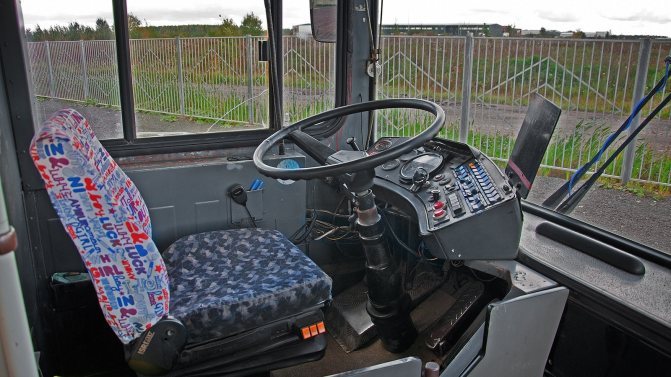
There are three pedals, although the gearbox is automatic - like on the BelAZ , but the meaning of the design is different. The one under the left foot is needed to open and close doors. The same function is duplicated by the buttons on the panel. MAN designers were very fond of buttons: they not only open and close doors, but also start and stop the engine, turn on lights, heaters, and even change automatic transmission gears. Let's try to press these buttons.
1 / 2
2 / 2
The sound of the engine is quite distinct, but not annoying, it is soft and even. We look in the mirrors. Visibility is good, although if the front door is open, almost nothing is visible in the right mirror. But you still can’t drive with the doors open, so we dismiss this remark as disorganized.
Let's look at the instruments. On the left we see two pressure gauges for the brake circuits, then indicators for fuel level, oil pressure and coolant temperature. Under the speedometer is a mechanical tachograph. I didn’t look at the instruments anymore, concentrating on driving.
1 / 3
2 / 3
3 / 3
Test drives / Used cars Foreign car for Soviet citizens: test drive of the Ikarus-256 bus Now, of course, it’s hard to imagine, but not so long ago, practically the only legal way to ride a “foreign car” was a trip to the Hungarian Ikarus. In the cabin of this “foreigner”... 38649 3 38 01/15/2016
I remember we once drove an Ikarus 256 . The feeling is very similar: a big old foreign car. Everything works, there is even a little more comfort than on some modern buses. But, unlike Ikarus, there is an “automatic machine”. Using the button, you can set the range of gear shifts: “1” – only the first gear, “2” – the first and second, “3” – respectively, all three. It’s a pity that there is no “4” button; it wouldn’t hurt here.
Of course, driving with an automatic transmission is much more pleasant, if not for one thing: the brake and especially gas pedals are very tight. Since the MAN begins to move immediately after releasing the brake pedal, with frequent stops and maneuvers you have to often press the brake and gas, which is why your hand soon reaches to your knee to help press it.
And yet, driving this bus is much easier than many others. The MAN has very long overhangs, but a short wheelbase (only 5.6 meters), so maneuverability is fine. There is a minimum of roll when cornering, and this despite the second floor and air suspension.
I’ll sing a special song to the brakes. Typically, on older vehicles, air brakes can be a little unpredictable: at first, when you press the brake pedal, nothing happens, and then it can happen so abruptly that you hit the steering wheel with your nose. Here the brakes work almost like on a passenger car: soft, gentle and expected.
The dynamics are not amazing. 200 l. With. and three gears of a 30-year-old “automatic” do not imply active driving. Yes, the city bus probably doesn’t need it. It’s much more pleasant to encounter a kind of delicacy on this vehicle that you don’t expect from a double-decker bus, the total weight of which can reach up to 12.5 tons. By the way, fuel consumption is also not low: a bus can “eat” up to 47 liters of diesel fuel per hundred kilometers.

What will happen next?
Re-equipment of the bus is ongoing. Some things have already been done, but there is still a lot of work ahead. I would like to install air conditioners (in sunny weather in the summer it can be hot on the second floor), make the salon a little more suitable for creativity, complete the work stations, add some household amenities (if you understand what I mean), and redesign the space a little. But even now you can already find him on the streets of the city. You’ll see - feel free to come in, it’s always interesting inside this “classbus”!
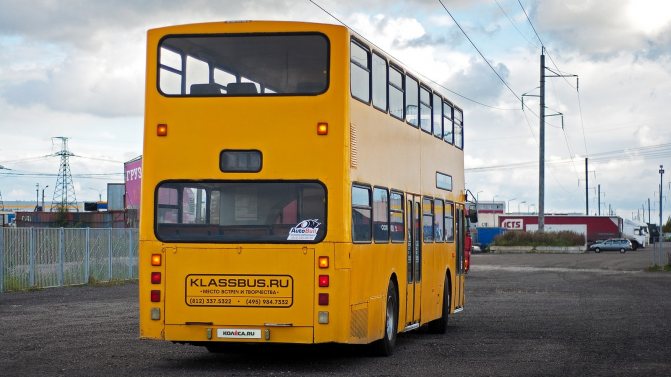
We also express our gratitude to Ivan Fedorov personally for his help in preparing the material.
